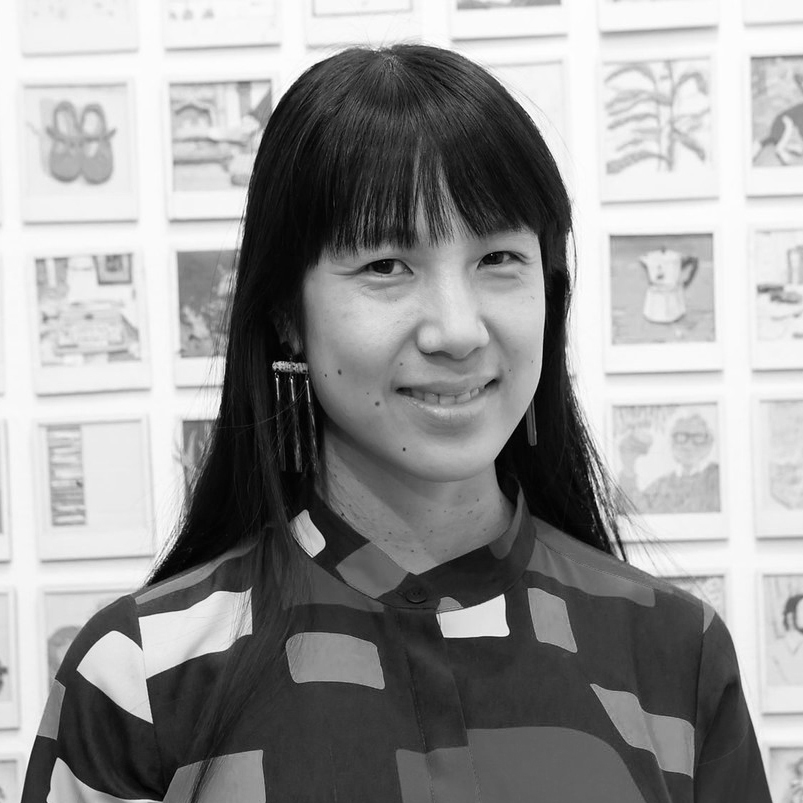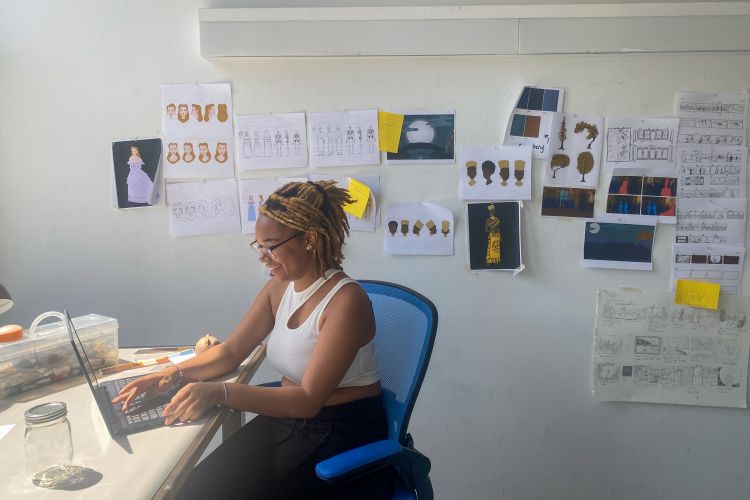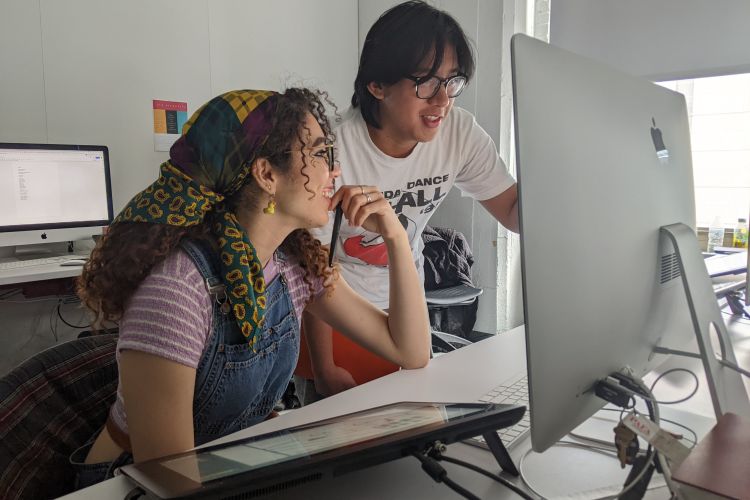Animation
PAFA's concentration in Animation offers students an opportunity to explore the ever-expanding world of this art form.
Our unique program connects PAFA's world-class undergraduate training in studio arts with moving imagery and narrative storytelling, emphasizing experimental fine art-based approaches to animation, including stop-motion and 2D animation techniques. The program also provides students with professional training on the latest digital platforms and techniques, preparing them for career paths in the animation industry.
PAFA has a long history with moving images that can be traced back to the institution's earliest days with founder Charles Willson Peale's "moving pictures". PAFA's narrative painting tradition laid the groundwork for many alumni to explore kinetic and time-based artforms, including pioneering experimental animator Mary Ellen Bute (1906–1983) and award-winning filmmaker and artist David Lynch. Lynch created his first moving work, Six Men Getting Sick, as a student at PAFA. This tradition continues to the present day, and PAFA offers video and moving image courses at both the graduate and undergraduate level, with numerous students and faculty working in various forms of time-based media.
Animations made by current and recent alumni of PAFA
2020-2021 Animation Student Reel
Featuring work by (in order of appearance): Sophia Teixido, Clarissa Kear, Marcus McGuire, Jesse Best, Aimee Liriano, Haley Powell, Eloise Avery, Darya Khristich, Ryan Foxx, Victoria Rivers, Michael Rodriguez, Nastassia Sharanhovich, Sofia Sierra, Eloise Avery, Nicholas Carlson, Mary-Beth Drabiszczak, Michaela Driggers, Clare Fitzgerald, Aesha Foley, Joelle Lemongelli, Hunter McKnight, Georgia Reeves, Jacklyn Pena, Basak Kilicbeyli, Jiatong Tian, Andrea Bozym, Heather Palmer, Bhoomi Patel, Marcus McGuire, Ava Haitz, Jesse Best, Jiatong Tian
Resources & Facilities
Albert M. Greenfield Animation Studios
On-campus digital resources exclusively for Animation include:
- Digital computer lab, home to 15 workstations with iMac computers and Cintiq tablets
- Stop motion room with a professional down-shooter set-up
- Stop motion room with a puppet stage
- An in-house sound studio suitable for professional audio recording and exhibiting video installations was completed in 2022.
The Pennsylvania Academy of the Fine Arts Albert M. Greenfield Animation Studios are made possible with a gift from The Albert M. Greenfield Foundation.
Arcadia Fine Arts Library and Media Lab
These facilities complement PAFA's existing Media Lab, set up for green screen video work and photography (including documentation of artwork), as well as access to equipment through PAFA’s Arcadia Fine Arts Library. Available digital equipment includes desktops, laptops, and various still and moving image cameras for in-class and outside use.
PAFA's digital labs are supported by a full-time technician, who keeps the computers and software up to date, runs instructional workshops, and provides students and faculty with assistance.
Screening Facilities
Animation students will enjoy multiple opportunities to exhibit work year-round at PAFA in a variety of settings. The Rhoden Arts Center, which opened in 2019, is a 265-seat state of the art auditorium, allowing students to display work in a professional theatrical environment on the Daniel W. Dietrich II Stage. Additionally, the adjacent Anne Bryan Gallery houses dedicated projection space for exhibiting work.
Chair of Animation
 Amy Lee Ketchum creates poetic narratives and abstract worlds in her animations which draw from personal and collective memory, metaphysical narratives, and dance. She was raised by first-generation Chinese immigrants in Los Angeles and studied art and architecture at UC Berkeley. Upon returning to Los Angeles, and frequenting independent theaters, she discovered her passion for film. Inspired by the visions of phantasmagoria on screen, she went on to pursue a Masters of Fine Art in Animation at the University of Southern California. Her work has been shown on broadcast independent television, various international film festivals, and on the Centre Pompidou web channel.
Amy Lee Ketchum creates poetic narratives and abstract worlds in her animations which draw from personal and collective memory, metaphysical narratives, and dance. She was raised by first-generation Chinese immigrants in Los Angeles and studied art and architecture at UC Berkeley. Upon returning to Los Angeles, and frequenting independent theaters, she discovered her passion for film. Inspired by the visions of phantasmagoria on screen, she went on to pursue a Masters of Fine Art in Animation at the University of Southern California. Her work has been shown on broadcast independent television, various international film festivals, and on the Centre Pompidou web channel.
Exhibitions include the Boston Center for the Arts, Space 1026, and the Shelburne Museum. Awards and Recognitions include Animation on the Edge Top Prize from the Los Angeles Animation Festival, National Finalist for Student Academy Awards. Festival Screenings include Ottawa International Animation Festival, Animasivo, and the New York International Children’s Festival.
Curriculum
As part of the BFA curriculum, the Animation concentration at PAFA requires 51 credits total.
Animation students will complete the same First Year Foundation curriculum that all PAFA students do, and will come to the animation courses with a strong grounding in perceptual drawing and painting, understanding of the figure and anatomy, and familiarity with processes in printmaking and sculpture.
Studio work is complemented by rigorous liberal arts studies that help students understand key concepts and clearly articulate their ideas. PAFA’s museum offers an extraordinary resource as students learn from the collection and special exhibitions. Talks by visiting artists, curators and scholars help students gain a greater awareness of important historical and contemporary artists and ideas.
| Course No. | Title | Credits | |
| First Year Foundation | |||
| FY 100 | Foundations Experience | 3.0 | |
| FY 101 | Structure and Form I | 3.0 | |
| FY 102 | The Figure I | 3.0 | |
| FY 103 | Print and Communication I | 3.0 | |
| FY 104 | Structure and Form II | 3.0 | |
| FY 105 | The Figure II | 3.0 | |
| FY 106 | Print and Communication II | 3.0 | |
| Second Year | |||
| AN 200 | Principles of Animation | 3.0 | |
| AN 201 | Production Processes | 3.0 | |
| AN 202 | 2D Animation | 3.0 | |
| AN 203 | Stop Motion Animation | 3.0 | |
| Third Year | |||
| AN 300 | Professional Practices and Internship | 3.0 | |
| AN 301 | Motion for Industry | 3.0 | |
| AN 302 | Film Pre-Production | 3.0 | |
| AN 303 | Alternative Cinematic Structures | 3.0 | |
| Fourth Year | |||
| AN 401 | Graduation Film 1 | 3.0 | |
| AN 402 | Graduation Film 2 | 3.0 | |
| Total Animation Credits | 51.0 | ||
| IN 330 | Studio Critique (6 total, 1.5 credits each) | 9.0 | |
| Total Studio Credits | 60.0 | ||
| Total Elective Credits | 21.0 | ||
| Total Art History Credits | 15.0 | ||
| Total General Studies Credits | 30.0 | ||
| Total Credits Required for Bachelor of Fine Arts Degree | 126.0 | ||
Courses
AN 200 Principles of Animation (3.0 credits)
In this introductory course, students will learn basic principles of movement that apply to all forms of animation regardless of technique. Through screenings of historical and contemporary precedents students will gain an understanding of what is possible in this interdisciplinary and versatile form of art. The course will cover techniques primarily in stop-motion and will also cover techniques such as 2D hand-drawn, stop-motion, and digital animation using programs such as Dragonframe, Photoshop, and Adobe After Effects. By the end of the course, students will understand the tools and procedures necessary to create a complete animation.
AN 201 Production Processes (3.0 credits)
Animating is just one aspect of making a moving image project. In this course students learn the process of storyboarding, editing and sound designing moving image projects. These skills will enable students to visualize and plan and enhance their projects. Students will develop skills in staging subjects, visualizing camera angles, and establishing emotional beats essential to telling powerful stories for sequential art. Additionally, through exercises such as taking field recordings, working with dialogue, and experimenting with the duration and sequence of shots, students will develop an understanding of how sound and editing affect the ability to communicate through moving images.
AN 202 2D Animation I (3.0 credits)
Students will apply the basics of animation introduced in Principles of Animation as well as the drawing skills attained from the Foundation Year to this course in 2D Animation. Using software such as Adobe Animate and Photoshop, students will learn to draw frame by frame to create the illusion of life. Students will complete exercises in character animation, objects responding to the laws of physics, and effects animation leading up to a final moving image project of the students’ design.
AN 203 Stop Motion Animation I (3.0 credits)
This course explores tactility, the laws of physics, and acting through stop motion puppet animation. Students learn to fabricate a puppet using armature wire and other materials and to animate it on a stage in three-dimensional space using the Dragonframe software. Additionally, students will learn to use work with green screen and composite animation with sets in Adobe After Effects. Through exercises and a final project, students will apply principles of movement to a three-dimensional object or puppet.
AN 300 Professional Practices and Internship in Animation (3.0 credits)
This course informs students about options for pursuing a career in animation including commercial, independent, and fine arts trajectories. It will also cover how to do taxes for creative professions, how to be an independent contractor, and how to start one’s own business. Visiting artists will share their experiences and give career advice. Additionally there will be an internship requirement so that students may graduate with relevant experience and establish professional contacts.
AN 301 Motion for Industry (3.0 credits)
Whether one chooses to be an animation artist or a commercial studio artist, it is likely that you will take commissions and work in a team setting as a moving image professional. This course prepares students to work with clients and collaborate with other artists to create a cohesive animation that effectively communicates a creative vision. By working with industry partners to create a moving image piece based on a prompt, students will gain professional experience and have a piece for their portfolio.
AN 302 Film Pre-Production (1.5 credits)
This course prepares students to begin production on their Graduation Film which they will work on during their Fourth Year. It will guide students through script-writing and storyboards, concept art and production planning, and have flexibility for individualized approaches to various projects. Whether a student plans to make an experimental film, installation, or narrative animation, this course will provide students with a structure to complete the pre-production phase of an animated project.
AN 303 Alternative Cinematic Structures (3.0 credits)
Animation has never been bound by the screen. In this course students envision alternative ways to employ animation such as in transmedia, interactive sculpture, installation, performance, and beyond. They will synthesize the skills and apply techniques attained in their second year to develop a concept to create a sophisticated animation project. Drawing on precedents from the history of expanded cinema and looking to contemporary examples, students will learn about how other moving image artists have made animations for contexts beyond the screen.
AN 401 Graduation Film 1
The Graduation Film is the culmination of the knowledge, skills, and experiences gained at PAFA. Students will continue working on the project developed during the Pre-Production course from the previous semester. Faculty will work with students on individualized plans to complete the various phases of their project. Through class and one-on-one critiques, students will problem solve and apply feedback to the making of their animations.
AN 402 Graduation Film 2
This course is the second part of Graduation Film 1. By the end of this class, students will have fully realized a sophisticated animation project that reflects their studio practice and artistic direction.
AH 200 History of Moving Images
This course traces the multiple trajectories of the moving image, from animation, video art, to commercial filmmaking. Students will learn about early animation toys, the advent of various technologies, and the practices of both independent and commercial moving image makers, from the avant-garde to Disney. Through screenings, readings, and independent research, students will acquire a broad understanding of the critical theory and history of animation, film, and video art.
Electives
Students will take 21 studio elective credits as part of their course of study. Studio electives in Painting, Drawing, Printmaking, Sculpture and Illustration are listed in the course catalog. Additionally the following two Animation specific electives will be offered.
AN 200 3D Animation
From projection mapping to fantasy films, 3D animation has changed the way people see the world. In this course students learn the basics of modeling, lighting, and animating in 3D using the software Maya. Students will become familiar with the interface and the vast range of tools available to create unique works of digital and moving image art. By the end of the course students will develop a project of their own design that relates to their interests and studio practice.
AN 304 Collaboration Studio (3.0 credits)
This course takes advantage of the wealth and variety of skills across departments at PAFA and combines them in this interdisciplinary moving image class. Students from Sculpture, Printmaking, Painting, Illustration, and Animation are all invited to use their specialized knowledge to collaborate on a unique film in a team oriented setting. It is geared towards students who intend to pursue a career in the fine arts who want to explore alternative forms and contexts for moving images that differ from traditional screens and commercial formats.
The Pennsylvania Academy of the Fine Arts Albert M. Greenfield Animation Studios and program are made possible with a gift from The Albert M. Greenfield Foundation.

